Last Updated on January 17, 2024 by Greg Gillson
I’ve put this resource together for you to answer your question: What birds are in my backyard in Tennessee?
This article lists and discusses the identification of the most common birds in your backyard. The birds chosen in this article are compiled from actual data from the citizen science program eBird. Thus, it is more accurate than some other similar articles you may find on the web. I provide pictures of each bird species mentioned and I’ll tell how to attract them to your backyard.
These are the most common backyard birds in Tennessee:
- Northern Cardinal
- Carolina Chickadee
- Carolina Wren
- Blue Jay
- American Crow
- Tufted Titmouse
- Mourning Dove
- American Robin
- Red-bellied Woodpecker
- Northern Mockingbird
- Downy Woodpecker
- Eastern Bluebird
- American Goldfinch
- Eastern Towhee
- European Starling
- House Finch
- Song Sparrow
- White-breasted Nuthatch
- White-throated Sparrow
- Dark-eyed Junco
- Yellow-rumped Warbler
- Indigo Bunting
- Barn Swallow
- Common Grackle
- Red-winged Blackbird
- Ruby-throated Hummingbird
- Brown Thrasher
- Chimney Swift
- Brown-headed Cowbird
- Eastern Phoebe
- Northern Flicker
Tennessee Birds and Birding in Tennessee State
eBird lists over 435 types of birds as occurring in the state of Tennessee.
The most common bird in Tennessee: the most frequently seen bird in the state is Northern Cardinal. It is reported on 61% of bird watching lists.
If you are serious about knowing the birds native to Tennessee, then check out eBird for Tennessee. It has recent sightings and photos, illustrated checklists with weekly abundance bar charts for state, counties, and individual hotspots of the best birding locations.
If you want to know about other people interested in birds in your area, join a local bird group. The American Birding Association maintains a list of bird watching clubs for each state.
Tennessee Bird Identification
This section is the species accounts. These are designed to help you to recognize birds you see in your backyard. I have used eBird to select the birds that are most common. “Common” means the birds seen most often throughout the year, not necessarily the most numerous.
Each species account starts with a photograph. In the identification section I am using size and shape and bill type before considering the color or patterns on the birds. I find these more reliable when trying to identify an unknown bird. Pay attention to body and tail shape and especially bill shape of birds you see, not just plumage color.
In the section on bird feeders and foods I tell how to attract each species. Not all types of backyard birds will come to feeders. But all backyard birds can be attracted with water. So don’t forget to add a birdbath to your bird feeding station.
Do you live in East Tennessee? West Tennessee? Middle Tennessee? Northeast Tennessee? Southeast Tennessee?
To appear in this article, most birds are widely distributed throughout the state and are often year-round residents. However, for those birds that are more localized in place or time, I list the general region and seasonality. Please see the section following these species accounts for the lists of common species by season.
Even if a species is found in a general area, they occur only in the habitat they prefer. So, the exact habitat of your neighborhood is important for the presence of absence of certain kinds of birds.
1. Northern Cardinal (Cardinalis cardinalis)
This is one of the most common and popular backyard birds in the eastern half of the United States.
 |
| Northern Cardinal. GeorgeB2 from Pixaby |
Range in Tennessee: Northern Cardinals are year-round residents throughout Tennessee.
Identification:
Size: Cardinals are a bit smaller than American Robins, about the same size as Red-winged Blackbirds.
Shape: Plump body with fairly long full tail. Wispy crest.
Bill: Short, heavy, conical, pink.
Color: That bright red color is matched by few other birds. Black face. The female is grayer, but with hints of red in wings and tail, and has a crest, too.
Habitat, range & behavior: Cardinals are year-round residents in shrubby woodland edges.
Found from the eastern United States to Texas and Arizona south into Mexico.
That large conical bill is made for chewing seeds. Watch them crack open sunflower seeds, spit out the hulls, and pluck the kernel with their tongues!
Food and feeder preference: Black oil sunflower seeds. Many types of seeds, berries, nuts in larger hopper or tray feeders.
You may like my in-depth article on attracting Northern Cardinals.
2. Carolina Chickadee (Poecile carolinensis)
Chickadees are common feeder birds throughout much of North America. This one is common in backyards in the southeastern United States.
 |
| Carolina Chickadee. GeorgeB2 from Pixabay |
Range in Tennessee: Carolina Chickadees are year-round residents throughout Tennessee.
Identification:
Size: This small bird is the size of an American Goldfinch.
Shape: Round body, round head, longer tail.
Bill: Short, straight, stout.
Color: Gray above. Paler below. Black cap, white face, black bib.
Habitat, range & behavior: Lower elevation deciduous forests, wooded residential areas.
This chickadee is a resident in the southeastern US.
Chickadees cannot chew as sparrows do, so they take one large sunflower seed at a time from your feeder and fly off to a branch to pound it open with their stout bills.
Food and feeder preference: Most of their diet is insects, also seeds. They will eat black oil sunflower seeds from hopper feeders.
3. Carolina Wren (Thryothorus ludovicianus)
This is a fairly common backyard bird in the much of the eastern United States.
 |
| Carolina Wren. theSOARnet from Pixabay |
Range in Tennessee: Carolina Wrens are year-round residents throughout Tennessee.
Identification:
Size: A smaller bird, between the size of American Goldfinch and House Finch.
Shape: Round body, short neck, flat head, long tail flipped about actively.
Bill: Fairly long, thin, pointed and slightly curved.
Color: Upper parts rusty brown with black bars on the wings and tail. A white eyebrow line and buff under parts.
Habitat, range & behavior: Shrubby thickets and brushy suburban yards.
It is found in the southeastern United States and Yucatan. Northern parts of range expand and contract depending upon harshness of winters.
Males sing throughout the year and are very loud for their size.
Food and feeder preference: Feed mostly on insects and spiders. They will feed on suet.
4. Blue Jay (Cyanocitta cristata)
A common and well-known bird in the eastern half of the United States.
 |
| Blue Jay. skeeze from Pixabay |
Range in Tennessee: Blue Jays are year-round residents throughout Tennessee.
Identification:
Size: About that of American Robin.
Shape: Fluffy, large crested head, ample tail. Large strong legs.
Bill: Black, long and stout.
Color: Blue above, white below. Black neck collar. White patches in wing.
Habitat, range & behavior: Woodlands and towns.
Found in the eastern half of the United States. In summer into southern Canada.
Bold and brash. May bully smaller birds. Jays gulp lots of seeds or other food at once, storing it in their crop. Then they fly off and bury food items in a hidden cache.
Food and feeder preference: Diet is omnivorous. They can quickly empty your feeder! Because they are also aggressive toward other feeder birds, some people put mesh cages around smaller bird feeders. Small birds can go through, squirrels and larger “pest” birds are prevented entry. Some people feed jays peanuts, perhaps away from the seed feeders.
5. American Crow (Corvus brachyrhynchos)
This larger all-black bird is common in cities and country. Its cawing call is familiar to most people.
 |
| American Crow. Greg Gillson |
Range in Tennessee: American Crows are year-round residents throughout Tennessee.
Identification: This is a key species for comparing with an unknown bird.
Size: About 17-1/2 inches long from bill tip to tail tip, though there is much size variation throughout its range. Larger than blackbirds and grackles. Smaller than ravens.
Shape: Thick neck, large head, rather short square-ended tail. Longer legs. In flight has rounded wing tips with each primary feather separated from others forming “fingers.”
Bill: As long as head, thick, black.
Color: Glossy black throughout.
Habitat, range & behavior: They prefer open areas with trees, fields, farms, cities.
They are common across most of the United States lower-48, except in the desert southwest. They move into southern Canada in summer.
They gather in evening communal roosts in large flocks that may number into the thousands and then move out at dawn into the surrounding area.
Food and feeder preference: Omnivorous, they feed on large insects, grain, small mammals, carrion. You probably don’t want these large entirely black birds in your backyard feeders. So don’t feed table scraps to birds.
6. Tufted Titmouse (Baeolophus bicolor)
Related to chickadees, these backyard birds lack the black bib, but have a crest instead.
 |
| Tufted Titmouse. anne773 from Pixabay |
Range in Tennessee: Tufted Titmice are year-round residents throughout Tennessee.
Identification:
Size: A small bird, but a large titmouse, this species is larger than chickadees, about the size of a junco or House Finch.
Shape: Rounded body, long full tail, big head, long legs.
Bill: Short and stout, compressed (taller than wide), black.
Color: Dark blue-gray above, pale below. Black feathers around eye accentuates its size.
Habitat, range & behavior: Lives in deciduous forests with heavy canopy, parks.
Found in eastern and southeastern United States is expanding its range north and west.
Backyard bird feeders might be helping this species expand its range northward.
Food and feeder preference: Their diet is insects and seeds. At your hopper or tray feeder they like black oil sunflower seeds and suet.
7. Mourning Dove (Zenaida macroura)
Mourning Doves are the most widespread and most frequent backyard bird in the Lower 48 states of the United States.
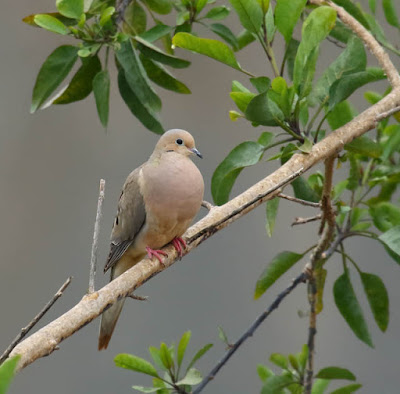 |
| Mourning Dove. Greg Gillson |
Range in Tennessee: Mourning Doves are year-round residents throughout Tennessee.
Identification: This is a key species for comparing with an unknown bird.
Size: About 12 inches long from bill tip to tail tip. About same size as Northern Flicker. Larger than American Robin. Slightly smaller than domestic city pigeon.
Shape: Very plump with a small round head. Tail is long and pointed. Legs are short.
Bill: Small and rather slender.
Color: Pale brown-pink body, darker wings and tail. White edges on side of tail.
Habitat, range & behavior: Semi-open areas such as urban areas, farmlands, woods. Often seen perched on wires, fences.
It is a resident across the lower-48 states and Mexico, with some movement out of northern areas in winter.
Their mournful cooing is a familiar spring birdsong.
Food and feeder preference: Mourning Doves eat seeds almost exclusively. Attract with black oil sunflower seeds on a large sturdy tray feeder or on the ground.
8. American Robin (Turdus migratorius)
This familiar backyard bird is a resident in the northern half of the United States and a common winter visitor in the southern half.
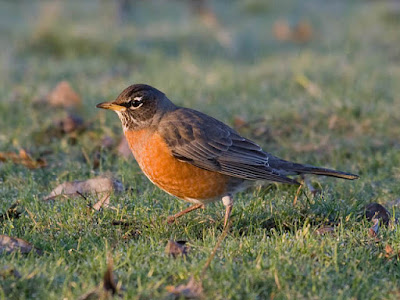 |
| American Robin. Greg Gillson |
Range in Tennessee: American Robins are year-round residents throughout Tennessee.
Identification: This is a key species for comparing with an unknown bird.
Size: 10 inches long from bill tip to tail tip. About the same size as a Blue Jay or one of the Scrub-Jays. Larger than Red-winged Blackbird. Smaller than a Mourning Dove.
Shape: Very plump with a fairly long tail.
Bill: Straight and fairly slender, curved at the tip.
Color: Gray-brown upperparts, rusty orange breast.
Habitat, range & behavior: Open woodlands, farmlands, urban parks and lawns.
Migratory, breeds north across Alaska and Canada. Resident in most of the United States (lower 48). Winters in the United States, Mexico, to central America.
Hops on your lawn turning head this way and that looking for food. Their caroling song is one of the early signs of spring in the north.
Food and feeder preference: Worms and other invertebrates in the lawn. May eat fruit from a tray feeder or the ground. Eat small berries from trees and bushes.
9. Red-bellied Woodpecker (Melanerpes carolinus)
This is one of the most common species in the eastern half of the United States.
 |
| Red-bellied Woodpecker. skeeze from Pixabay |
Range in Tennessee: Red-bellied Woodpeckers are year-round residents throughout Tennessee.
Identification:
Size: Fairly large for a backyard bird. Between a Starling and American Robin in size. Smaller than a Northern Flicker.
Shape: Stout with large head and short tail. Clings to tree trunk on strong short legs propped up with short stiff tail.
Bill: Long, chisel shaped.
Color: Pale gray body, many thin black-and-white bars across back and wings. Red nape, extending forward on crown on male.
Habitat, range & behavior: These birds are found in many woodland types, including oak, hickory and pine.
They are found from the eastern slope of the Rocky Mountains in the lower-48 states from Texas to extreme southern Canada, and eastward from Florida northward just to the southern edge of the New England states.
In typical woodpecker fashion, it hitches up the tree trunk and larger branches.
Food and feeder preference: This species eats insects and nuts. They may eat peanuts from a tray feeder and eat from a suet block.
10. Northern Mockingbird (Mimus polyglottos)
This bird sings from exposed perches most of the year and often through the night. They have an unending supply of their own unique short phrases that they repeat about 3 times each, but frequently intersperse songs of other birds.
 |
| Northern Mockingbird. Greg Gillson |
Range in Tennessee: Northern Mockingbirds are year-round residents throughout Tennessee.
Identification:
Size: The length of an American Robin.
Shape: Slender and long tailed. Long legs.
Bill: Medium length, slender, slightly curved.
Color: Gray, darker above, with white patches in wing and tail.
Habitat, range & behavior: They prefer edge habitat with scattered trees and bushes, parks and residential areas.
It is found in eastern and southern parts of the US, West Indies, and south into Mexico. In summer birds are found a bit farther north.
They boldly defend their nests from other birds, cats, and intruders.
Food and feeder preference: Diet is insects, berries, and fruit. You may attract mockingbirds to your feeder with grapes, raisins, apple slices. They will come to a suet block. They readily use a bird bath.
11. Downy Woodpecker (Dryobates pubescens)
This tiny woodpecker is found in backyards across the United States.
 |
| Downy Woodpecker. Greg Gillson |
Range in Tennessee: Downy Woodpeckers are year-round residents throughout Tennessee.
Identification:
Size: Bigger than a junco or House Finch. Smaller than a Red-winged Blackbird. About the same size as a White-crowned Sparrow, but with a much shorter tail.
Shape: Stocky with large head and short stiff tail.
Bill: Short, chisel shaped.
Color: Black-and-white striped head. Black wings with white spots. Solid white back. White under parts. Black tail with white outer tail feathers with black bars or spots. Male with small red spot at back of head.
Habitat, range & behavior: Found in small deciduous trees, willows, and even weed stocks such as teasel, especially near water.
Ranges coast-to-coast across all but northernmost parts of Canada and Alaska south to the southern US. Absent in the desert southwest.
Interestingly, I learned today that the males may more often be found in smaller plants and twigs, while females are more likely on tree trunks.
Food and feeder preference: Insects, fruits, and seeds. Gleans arthropods from the bark of trees. Attract with suet feeder. Will also eat black oil sunflower seeds
12. Eastern Bluebird (Sialia sialis)
A beloved bird of open fields with trees and fence lines for perching.
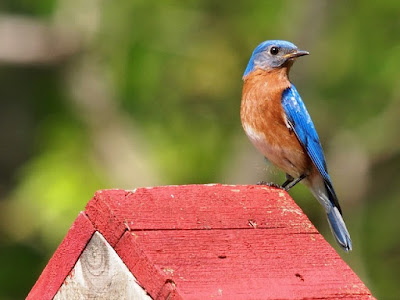 |
| Eastern Bluebird. skeeze from Pixabay |
Range in Tennessee: Eastern Bluebirds are year-round residents throughout Tennessee.
Identification:
Size: Larger than House Finches. Much smaller than starlings. About length of White-crowned Sparrow but differently proportioned.
Shape: Chunky, large head, short tail. Bill: Straight, fairly slender, curved at tip.
Color: Males are brilliant blue above (including wings and tail), rusty orange below with white belly and under tail. Females are often much paler, almost grayish.
Habitat, range & behavior: Found in pasture, fields, golf courses, open woodland edges.
They are resident in most of eastern US, highlands of Middle America. In summer reach northernmost eastern US and southernmost eastern Canada, withdrawing somewhat in winter.
They readily use nest boxes, but the entrance hole must be smaller than the head of a starling, and without a perch.
Food and feeder preference: They eat flying insects primarily, but also other invertebrates and berries. They will eat mealworms at your feeder and frequent birdbaths.
13. American Goldfinch (Spinus tristis)
A beautiful tiny backyard finch familiar to many in its bright yellow summer plumage. Colloquially called a “wild canary.”
 |
| American Goldfinch. Greg Gillson |
Range in Tennessee: American Goldfinches are year-round residents throughout Tennessee.
Identification: This is a key species for comparing with an unknown bird.
Size: Very small at about 5 inches from bill tip to tail tip. Similar in size to a chickadee. Larger than hummingbirds. Smaller than juncos and House Finches.
Shape: Tiny, somewhat plump with larger head and short tail.
Bill: Short, conical, pink.
Color: Males in summer are bright lemon yellow with black forehead and black wings and tail with white bars. White under tail coverts. Females re dull olive, wings and tail browner. Winter birds are pale grayish-yellow with tan and brown wings and tail.
Habitat, range & behavior: This species is found in weedy fields and similar clearings with thistles and similar plants.
It is found coast-to-coast throughout the year across most of the middle lower-48 states. In summer moves north to the Canada border. In the winter found south to the Mexico border.
The flight is highly undulating, rising and falling as they flap in short bursts. Besides a long, sweet lilting song, they call in flight a lilting 4-part: “potato chip!”
Food and feeder preference: Feeds on weed seeds, thistle seed. May eat black oil sunflower seeds from tube feeder. Attract with Niger seed in a feeder called a “thistle sock.”
You may like my in-depth article on attracting American Goldfinches.
14. Eastern Towhee (Pipilo erythrophthalmus)
This big ground-dwelling sparrow was recently split from Rufous-sided Towhee, creating the Eastern Towhee in the East and the Spotted Towhee in the West.
 |
| Eastern Towhee. skeeze from Pixabay |
Range in Tennessee: Eastern Towhees are year-round residents throughout Tennessee.
Identification: )
Size: About the length of a White-crowned Sparrow; larger than a House Finch, smaller than a Starling or Red-winged blackbird.
Shape: Rather bulky compared to other sparrows, large head, long rounded tail.
Bill: Short, conical.
Color: Blackish above, rusty sides, white belly. Females paler and browner. White tail corners. White wing patch.
Habitat, range & behavior: They live in brushy areas, hedges, woodland edges.
Found in the eastern United States. Resident in SE US, in summer the move north to the border with Canada. They rummage around in leaf litter under thick bushes, kicking and scratching the ground with both feet at once.
Food and feeder preference: Eat mostly insects and invertebrates in summer, adding berries, fruits, and especially seeds in winter.
At your feeder they will visit a hopper feeder but may prefer a wide platform feeder. They may more often feed on the ground under the feeder.
15. European Starling (Sturnus vulgaris)
Introduced to North America in the late 1800’s, they crossed the continent, often to the detriment of native cavity-nesting birds. The prime example of an invasive species.
 |
| European Starling. Greg Gillson |
Range in Tennessee: European Starlings are year-round residents throughout Tennessee.
Identification: This is a key species for comparing with an unknown bird.
Size: 8-1/2 inches from bill tip to tail tip. About the size of a Red-winged Blackbird. Smaller than an American Robin. Larger than a White-crowned Sparrow or Spotted/Eastern towhee.
Shape: Stocky with large head, short square-ended tail. Longer legs.
Bill: As long as head. Sharp pointed. Yellow in spring, otherwise dark.
Color: They are grayish brown much of the year, with glossy iridescence and white spotting during the spring.
Habitat, range & behavior: Lowland birds that need trees large enough for nest cavities but plenty of open area for feeding. They are most abundant in urban and suburban areas where they find food and artificial nest cavities.
Resident from coast-to-coast from southern Canada to northern Mexico. In summer north across Canada and Alaska. Native range is Europe to Pakistan, north Africa.
Often viewed as a pest, starlings often bully other backyard birds, taking over bird feeders, and stealing nest cavities from smaller native birds. In winter they can form into flocks of tens of thousands.
Food and feeder preference: Primarily insects when available, often feeding on the ground. Discourage them from your backyard hopper and tray feeders by never feeding birds table scraps (including bread or meat). They have weak feet and do not perch well on tube feeders. A cage mesh around smaller hopper feeders may keep them out.
16. House Finch (Haemorhous mexicanus)
Originally a bird of the West, now found in backyards across most of the US. There are other red finches, but these are the ones most likely in residential areas.
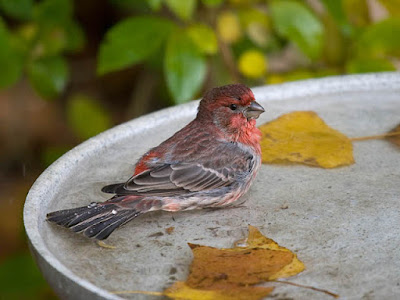 |
| House Finch. Greg Gillson |
Range in Tennessee: House Finches are year-round residents throughout Tennessee.
Identification: This is a key species for comparing with an unknown bird.
Size: About 6 inches from bill tip to tail tip. Larger than goldfinches and chickadees. Smaller than a White-crowned Sparrows or Spotted/Eastern towhees.
Shape: Medium build with a medium-long notched tail. Round head.
Bill: Short, conical.
Color: Brown and gray above with streaks on the sides of the pale underparts. Males with red (sometimes orange or rarely yellow) crown, chest, rump.
Habitat, range & behavior: You’ll find small flocks on wires, in short treetops and in bushes. Originally deserts and grasslands. Rural areas and towns are where they’re now most common.
Formerly found in the western United States and Mexico. Then introduced into the northeastern United States, but now found in nearly all of the lower-48 states and extreme southern Canada. Rare in plains states (Dakotas to Texas) and southern Florida.
House Finches are not territorial, but males sing throughout the year–a lively, wiry song ending in a couple of buzzy notes.
Food and feeder preference: They love sunflower seeds; attract them with tube feeders. May eat from thistle socks.
You may like my in-depth article on attracting House Finches.
17. Song Sparrow (Melospiza melodia)
A common bird, but variable, and similar to many other streaked brown sparrows.
 |
| Song Sparrow. Greg Gillson |
Range in Tennessee: Song Sparrows are year-round residents throughout Tennessee.
Identification:
Size: A smaller bird, similar in size to House Finch and juncos. Larger than chickadees and goldfinches. Smaller than White-crowned Sparrows or Spotted/Eastern towhees.
Shape: Plump with round head, long rounded tail.
Bill: Short, conical.
Color: Highly variable in darkness and color saturation across its range (dark rusty to pale gray). Generally gray-brown above with dark brown streaking on back. Complicated head pattern. Streaking on sides and breast converge into dense central breast spot.
Habitat, range & behavior: Thickets, especially near water. Backyard shrubbery.
Resident in western United States, western Canada, coastal southern Alaska, northeastern US. In summer also moves into mid-Canada and northern half of US. In the winter found in most of the US lower-48. Also, a population in central Mexico.
Forages on ground, never far from low cover to which they fly if startled.
Food and feeder preference: They feed on seeds and insects near the ground. Will visit hopper and tray feeders for mixed bird seed.
18. White-breasted Nuthatch (Sitta carolinensis)
A favorite feeder bird for many for its active antics and fearlessness. Though a small bird it is the largest nuthatch in North America.
 |
| White-breasted Nuthatch. Greg Gillson |
Range in Tennessee: White-breasted Nuthatches are year-round residents throughout Tennessee.
Identification:
Size: About chickadee-sized in length. Smaller than a junco or House Finch.
Shape: Appears large-headed, neckless, very short tailed. Short legs.
Bill: Nearly as long as head, straight, thin.
Color: Blue-gray above, white below. Black cap, wing tips, tail. Rusty feathers under tail.
Habitat, range & behavior: Common in oak and oak-pine woodlands, wooded towns.
Found across the United States, southern Canada, mountains of central Mexico. Absent from treeless grasslands, deserts in the west.
Crawls over tree branches and head-first down tree trunks searching for insects.
Food and feeder preference: Diet is insects, seeds, acorns and other nuts. Attract with black oil sunflower seeds feeding on hopper and tray feeders. Suet blocks.
19. White-throated Sparrow (Zonotrichia albicollis)
A fairly common bird of northern forests that visits backyards across much of the US.
 |
| White-throated Sparrow. Greg Gillson |
Range in Tennessee: White-throated Sparrows are winter visitors throughout Tennessee.
Identification:
Size: Similar in size to White-crowned Sparrow. Bigger than a House Finch; smaller than a starling.
Shape: Longer body. Round head on short neck. Long tail with notched tip.
Bill: Short. conical.
Color: Striped tan and brown above, pale gray below. White-striped form with black and white head stripes. Tan-striped form with tan and brown striped head. First year birds are similar to tan-stiped adults, but streakier overall. Yellow spot between eyebrow and bill. White throat strongly offset from gray breast and face.
Habitat, range & behavior: Found in forests, brush, and open woodland edges.
Breeds across Canada and northernmost Eastern United States. Winters in the eastern US, southern central US, and rare but regular along the West Coast.
Found in small flocks on ground near brush into which they can flee. Kick up leaves to search under for food.
Food and feeder preference: Eat seeds and berries in winter, more insects and fruit in summer. In your feeder will eat mixed seeds on a platform feeder and on the ground.
20. Dark-eyed Junco (Junco hyemalis)
Colloquially called “snowbirds,” they often arrive in backyards in winter from nearby mountain forests or more northern climes.
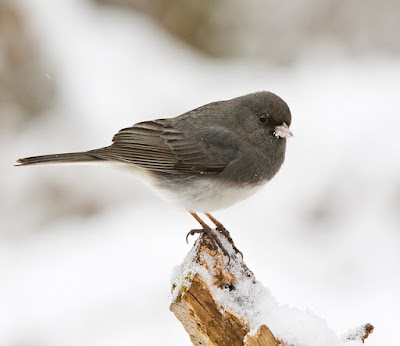 |
| Dark-eyed Junco. skeeze from Pixabay |
Range in Tennessee: Dark-eyed Juncos are winter visitors throughout Tennessee.
Identification:
Size: Small birds about the size of a House Finch.
Shape: Round body, short neck, round head, fairly long square-ended tail.
Bill: Short, pointed, conical, pink.
Color: Eastern birds are a darker all-gray with white belly. Western birds have jet black hood over head, brown back, and pink sides.
Habitat, range & behavior: Breed in coniferous forests. Winters widely. Avoids heavy brush, preferring widely spaced bushes.
Breeds across most of Canada, Alaska, and the western half of the United States. Winters from southern Canada and all of the lower 48-states to extreme northern Mexico.
Spend much of their time hopping and feeding on the ground.
Food and feeder preference: Eats mostly seeds, also insects in summer. Readily feed at backyard feeders on mixed seeds on hopper or tray feeders and ground.
You may like my in-depth article on attracting Dark-eyed Juncos.
21. Yellow-rumped Warbler (Setophaga coronata)
An abundant winter visitor to treetops and weedy areas.
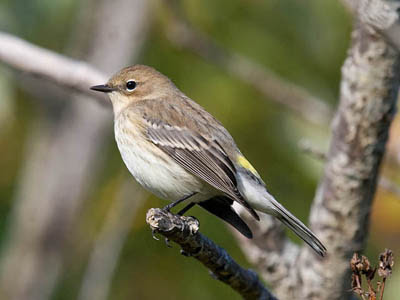 |
| Yellow-rumped Warbler. Greg Gillson. |
Range in Tennessee: Yellow-rumped Warblers are winter visitors throughout Tennessee.
Identification:
Size: Small, they are a bit larger than chickadees and goldfinches. They are smaller than House Finches and juncos.
Shape: Plump and neckless with a shorter tail.
Bill: Short, slender, straight, pointed.
Color: Breeding plumage in spring is blue-gray on the upper parts, black sides and chest, yellow rump, yellow on sides. Two forms: western form with yellow throat and large white wing patch; eastern and northern form with white throat and two white wing bars. In winter plumage both forms are gray-brown above, pale cream below. Yellow rump and white tail corners in flight.
Habitat, range & behavior: In breeding season mostly in coniferous or mixed forests, in mountains in west. In winter open areas with fruiting shrubs and scattered trees.
Breed across Canada and Alaska and in conifer forests in the west. Winter along both coasts and the southern states through Middle America. There are also non-migratory forms in Mexico and Guatemala.
They tend to forage in outer branches about half way up the tree.
Food and feeder preference: Yellow-rumped Warblers eat mainly insects in the summer. They switch to waxy berries and fruit in winter. They are thus able to winter farther north than other warblers. They are attracted to suet feeders.
22. Indigo Bunting (Passerina cyanea)
Don’t mistake Indigo Buntings for the larger Blue Grosbeak. As the name suggests, the grosbeak has a much larger and thicker bill, along with rusty wing bars, lacking in Indigo Buntings.

Range in Tennessee: Indigo Buntings are summer residents throughout Tennessee.
Identification:
Size: These birds are a bit smaller than a House Sparrow.
Shape: Plump. Large round head. Medium short tail.
Bill: Large and conical.
Color: Males are deep blue. Females are pale gray-brown with diffuse streaks below.
Habitat, range & behavior: Open woodlands and clearings. Country farm roads.
They are found in the East and parts of the Southwest, north to southern Canada.
Sing from the tallest tip of tree or telephone lines, a cheerful paired bouncy song very similar to American Goldfinch. In fact, they are sometimes called “blue goldfinches” because of this!
Food and feeder preference: These birds will eat seeds from hopper feeders, perhaps more so in the late spring when they first arrive during migration.
23. Barn Swallow (Hirundo rustica)
These common swallows are widely distributed throughout the world, primarily breeding in the northern hemisphere, and wintering in the mid-latitudes and southern hemisphere.
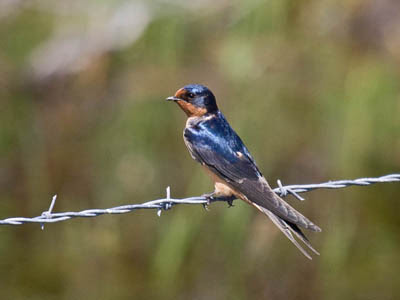 |
| Barn Swallow. Greg Gillson. |
Range in Tennessee: Barn Swallows are summer residents throughout Tennessee.
Identification:
Size: About the size of a House Finch but with a much longer tail.
Shape: Stocky, short necked but with long body and tail. Tail is forked, with very long outer tail feathers. Wings pointed.
Bill: Short, wide.
Color: Glossy dark purplish-blue above. Pinkish-orange below.
Habitat, range & behavior: Barn Swallows live in open country, frequently near humans. Farmlands. Nest in barns, under small bridges.
In North America breed from Mexico to northern Canada and Alaska, wintering from southern Mexico throughout most of South America.
Frequently seen swooping low over the ground hunting flying insects. Perch on wires, fences. Voice is twitters and chirps with grating sounds.
Food and feeder preference: Eat flying insects on the wing and are not attracted to backyard feeders.
24. Common Grackle (Quiscalus quiscula)
Sometimes considered a pest to crops, grackles are longer and lankier than very similar blackbirds.
 |
| Common Grackle. GeorgiaLens from Pixabay |
Range in Tennessee: Common Grackles are year-round residents throughout Tennessee.
Identification:
Size: Larger than Red-winged Blackbirds, they are near the length of Mourning Doves.
Shape: Long, with long full keel-shaped tail, long legs, flat crown.
Bill: Longer than head, pointed, but stouter than other blackbirds.
Color: Glossy black with hint of bronze or green on head (depending upon population). Yellow eye.
Habitat, range & behavior: They are found in agricultural areas, woodland edges, city parks and lawns.
Resident in the southeastern United States. In summer they migrate northward and west to the central United States and Canada.
They monopolize feeders and are bullies toward other birds.
Food and feeder preference: Grain, corn, acorns, small aquatic fish and amphibians. To discourage them, use tube feeders, rather than hopper or tray feeders. Don’t over-feed, keep spilled seed picked up.
25. Red-winged Blackbird (Agelaius phoeniceus)
These noisy flocking birds are most often found in marshes. But in winter they are found in backyards.
 |
| Male Red-winged Blackbird. Greg Gillson. |
 |
| Female Red-winged Blackbird. Greg Gillson. |
Range in Tennessee: Red-winged Blackbirds are year-round residents throughout Tennessee.
Identification: This is a key species for comparing with an unknown bird.
Size: About 8-3/4 inches long from bill tip to tail tip. About the size of a Northern Cardinal. Smaller than an American Robin.
Shape: Pot-bellied with a longer bill and flat forehead. Tail average.
Bill: Long and sharp pointed.
Color: Males are black with red and yellow shoulder patch. Females are streaked brown and rusty (sparrow-like but pointed bill and flat forehead).
Habitat, range, and behavior: Cattail marshes and wetlands are their summer habitat. In winter they feed in grain fields.
They breed across most of the North American continent. In winter they withdraw from most of Alaska and Canada.
They are found in colonies in summer and large flocks in winter.
Food and feeder preference: They eat insects in summer. In winter they eat grain and seeds. They visit feeders, more often in large winter flocks, and eat most seeds and suet.
26. Ruby-throated Hummingbird (Archilochus colubris)
This is the only hummingbird that breeds in the eastern half of the United States and Canada.
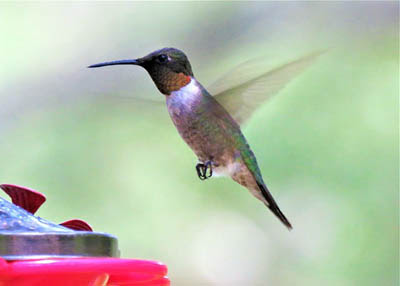 |
| Ruby-throated Hummingbird. GeorgeB2 from Pixabay. |
Range in Tennessee: Ruby-throated Hummingbirds are summer residents throughout Tennessee.
Identification:
Size: A tiny bird, much smaller than any other in the eastern US, except perhaps some other rare hummingbird.
Shape: The small body is chunky, with a big head, and short tail.
Bill: Very long and tubular, slightly down curved.
Color: Metallic green above, white below with scattered green or gray feathers. Male with glimmering ruby red throat that is black unless it refracts sunlight at just the right angle.
Habitat, range & behavior: They find flowers at forest edges and flower gardens.
They summer in the eastern US and southern Canada, east of the Rocky Mountains. Some winter in from the coast of the Carolinas to Florida and along the Gulf Coast.
Darting flight on a blur of wings that buzz when they flap so fast! They feed by poking their long bill into flowers.
Food and feeder preference: They drink flower nectar from tubular flowers using their long brush-tipped tongue. They also feed on spiders and small flying insects. They are readily attracted to hummingbird feeders filled with sugar water.
27. Brown Thrasher (Toxostoma rufum)
These birds are accomplished singers, with over 1100 different songs recorded!
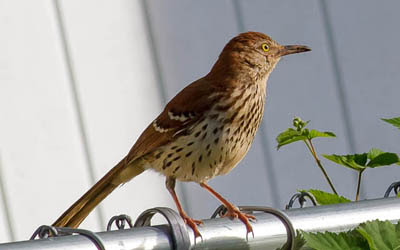 |
| Brown Thrasher. Linda Jones. CC0. |
Range in Tennessee: Brown Thrashers are year-round residents in most of Tennessee, but summer residents only in the extreme eastern part of the state.
Identification:
Size: Longer than a robin, smaller than a flicker.
Shape: Pot-bellied. Long tail with rounded tip. Large head.
Bill: Long and thin, slightly curved down.
Color: Rusty above. Gray face. Heavy rusty streaks below on cream-colored under parts. Two white wing bars.
Habitat, range & behavior: These birds live in woodland edges and hedges.
They are year-round residents in the Southeast. In summer they also breed northward, east of the Rocky Mountains to southern Canada.
You may find them feeding on the edge of lawns with a very horizontal posture. They may mimic other bird songs and calls.
Food and feeder preference: They primarily eat insects and invertebrates. But they will also come to platform feeders for sunflower seeds, nuts, suet, berries.
28. Chimney Swift (Chaetura pelagica)
Swifts have such small weak feet that they cannot perch on wires or trees like swallows. Look for them high in the air chasing bugs with rapid wingbeats.
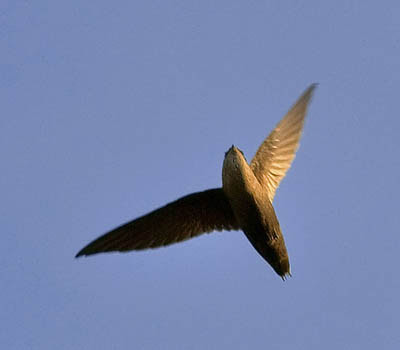 |
| Chimney Swift. Jim McCulloch CC 2.0 |
Range in Tennessee: Chimney Swifts are summer residents throughout Tennessee.
Identification:
Size: Small bird. Smaller than House Finches or Cliff Swallows.
Shape: Small head on short neck, very short tail. Thin pointed wings with no apparent bend at the wrist as most other birds.
Bill: Very short, wide.
Color: Gray-brown throughout.
Habitat, range & behavior: Open sky, above forests or residential areas.
They are summer residents east of the Rockies from southern Canada southward. They do not winter in the United States.
In fall migration they form large flocks of hundreds or thousands and swirl into large chimneys at dusk. Because the upper arm is so short as to barely exist, the flight of swifts is described as rapid and twinkly, not smooth and graceful as swallows.
Food and feeder preference: Insects caught on the wing. Will not visit feeders.
29. Brown-headed Cowbird (Molothrus ater)
Cowbirds are small blackbirds lay their eggs in the nests of other smaller birds, such as warblers. The adoptive parents raise their young!
 |
| Brown-headed Cowbird. Greg Gillson. |
Range in Tennessee: Brown-headed Cowbirds are year-round residents throughout Tennessee.
Identification:
Size: Larger than White-crowned Sparrows, but smaller than Rose-breasted or Black-headed Grosbeaks. Smaller than other blackbirds, starlings, and grackles.
Shape: Perhaps a little bit pot-bellied. Medium length tail. Flat forehead as typical for blackbirds.
Bill: Rather thick and stout.
Color: Males are glossy black with rich brown head. Females are dusty gray-brown throughout. Long-held juvenile plumage similar to pale female, scaly, being fed by Yellow Warbler or Song Sparrow or a hundred other host species.
Habitat, range & behavior: They are found in woodlands and farms. Also, with other blackbirds in winter at shopping center parking lots.
In summer they breed across Canada and most of the United States and Mexico. In winter they move south out of Canada and occupy both coasts and southeastern States in the US.
These small blackbirds join other flocks of blackbirds in cattle feedlots. You may see cowbirds riding on the backs of cattle, sheep, or horses. They originally rode on the backs of American bison on the Great Plains but expanded when forests were cut.
Food and feeder preference: Cowbirds eat grains, seeds, and insects. They will readily come to hopper and platform feeders. They are larger and more aggressive, so keep other birds from feeders and have a big appetite!
30. Eastern Phoebe (Sayornis phoebe)
This plain bird is common in backyards in the East.

Range in Tennessee: Eastern Phoebes are year-round residents throughout Tennessee.
Identification:
Size: About the size of bluebirds. Larger than House Sparrows.
Shape: Rather stout, with long wings, medium-length tail. Pointed but flat bill. Upright posture.
Bill: Black, pointed, wide and flat.
Color: Brownish-gray above, slightly yellow-olive on sides. White under tail coverts. No eye ring or wing bars help distinguish them from some other flycatchers.
Habitat, range & behavior: Found in woodlands, suburbs, farms. Frequently nest in rafters, under eaves, porches.
They are summer residents east of the Rocky Mountains from Canada southward. Year-round residents through the interior of the Southeast, to Texas. Winter visitor to Gulf Coast and southern Atlantic.
Phoebes pump their tail down. They also frequently spread their tails.
Food and feeder preference: They eat flying insects that they catch on the wing. Not a feeder visitor.
31. Northern Flicker (Colaptes auratus)
Of all the bird identification questions I get asked, this common larger backyard bird is the bird most people ask about. It doesn’t occur to those unfamiliar with it that this could be a woodpecker.
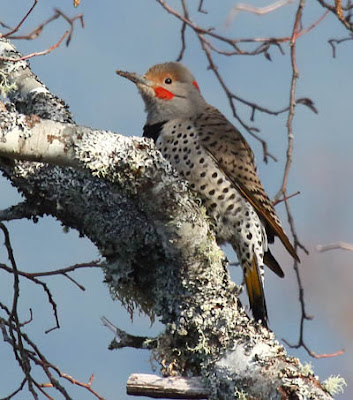 |
| Northern Flicker. Greg Gillson. |
Range in Tennessee: Northern Flickers are year-round residents throughout Tennessee.
Identification:
Size: About the size of a Mourning Dove. Larger than a robin.
Shape: Stocky with short legs, short tail, big head.
Bill: As long as head, thin, slightly curved.
Color: Back is brown with black bars. Under parts pinkish with black spots. Undersides of black wing and tail feathers are bright salmon red (West) or yellow (East). Head gray (West) or brown (East) and males with red (West) or black (East) whisker marks and nape marks (East). Black crescent across chest. White rump seen in flight.
Habitat, range & behavior: Found in woodland edges and forests.
Year-round resident from extreme southern Canada, across all of the lower-48 states and in the mountains of Mexico and Middle America. In summer breeds northward well into Canada and Alaska.
Frequently noted hopping on ground pecking in the ground for insects. In late spring, males proclaim their territory by rapid pounding on a hollow tree branch, though the ringing of metal downspouts at dawn is louder and carries much farther, to the exasperation of anyone trying to sleep inside!
Food and feeder preference: Ants and beetles are their primary foods. Will eat black oil sunflower seeds and are attracted to suet.
Common Birds in Tennessee
To determine how common each species is I used the data from actual bird sightings from the citizen science program eBird. Birds are listed by frequency. That is, how often the species is recorded on checklists submitted to eBird (a percentage).
When choosing the birds to include in this article I leaned strongly to birds that are present throughout the year in good numbers. Thus, many of the common birds are year-round residents. This means that they live in the same location all year. They raise their young in your neighborhood. They don’t migrate. Or if the species does migrate, the ones living in your area don’t. If this is the case, some migrants may move into your area during certain times of year, adding to the same species that are in your yard full time.
Some migrant birds visit your yard during the “summer.” Often, they arrive in spring and remain until late fall. They nest and raise their young in your neighborhood. These are the summer residents.
Other migrant birds visit your backyard during the “winter.” Some of these winter visitors may arrive in July and remain into April. Others may only be found in the cold of December or January. They key here is that they nest and raise their young somewhere else. They only visit your yard in the non-breeding season.
Migration is an amazing spectacle.
There will be birds that fly through your region in spring or fall (or both). They may visit your backyard only a few days or weeks a year. They aren’t regular enough, or stay long enough, to be included in this article. But the number of briefly visiting migrant birds could double the number of species presented here. You may see them over time. Consult checklists in eBird for your county to see what is possible.
I have generally excluded common waterfowl, birds of prey, shorebirds, seabirds, and others that aren’t usually found in residential areas. But they may certainly fly over or be seen regularly if your home is on a shoreline, for instance.
Most common backyard birds in Tennessee throughout the year
The following list is the backyard birds that are, on average, most common throughout the entire year. The list is ordered by most common based on the frequency of how often each species is recorded on checklists submitted to eBird.
- Northern Cardinal (61% frequency)
- Carolina Chickadee (49%)
- Carolina Wren (48%)
- Blue Jay (47%)
- American Crow (46%)
- Tufted Titmouse (44%)
- Mourning Dove (42%)
- American Robin (41%)
- Red-bellied Woodpecker (38%)
- Northern Mockingbird (36%)
- Downy Woodpecker (33%)
- Eastern Bluebird (32%)
- American Goldfinch (31%)
- Eastern Towhee (29%)
- European Starling (29%)
- House Finch (29%)
- Song Sparrow (27%)
- White-breasted Nuthatch (22%)
- White-throated Sparrow (20%)
- Red-winged Blackbird (18%)
- Eastern Phoebe (17%)
- Common Grackle (16%)
- Brown Thrasher (15%)
- Yellow-rumped Warbler (15%)
- Northern Flicker (15%)
Most common backyard birds in Tennessee in winter
- Northern Cardinal (57% frequency)
- Carolina Chickadee (49%)
- Carolina Wren (43%)
- American Crow (43%)
- Tufted Titmouse (43%)
- Blue Jay (42%)
- American Robin (40%)
- Mourning Dove (38%)
- Red-bellied Woodpecker (37%)
- Downy Woodpecker (35%)
- Northern Mockingbird (34%)
- Song Sparrow (33%)
- White-throated Sparrow (32%)
- House Finch (31%)
- Eastern Bluebird (30%)
- American Goldfinch (29%)
- European Starling (28%)
- White-breasted Nuthatch (23%)
- Dark-eyed Junco (23%)
- Eastern Towhee (22%)
- Yellow-rumped Warbler (21%)
Most common backyard birds in Tennessee in summer
- Northern Cardinal (64% frequency)
- Mourning Dove (51%)
- Carolina Wren (49%)
- American Robin (45%)
- American Crow (42%)
- Blue Jay (41%)
- Carolina Chickadee (41%)
- Northern Mockingbird (40%)
- Tufted Titmouse (40%)
- Eastern Towhee (37%)
- Indigo Bunting (36%)
- American Goldfinch (34%)
- Eastern Bluebird (33%)
- House Finch (33%)
- Red-bellied Woodpecker (31%)
- Barn Swallow (29%)
- Downy Woodpecker (28%)
- European Starling (27%)
- Song Sparrow (24%)
- Common Grackle (24%)
- Red-winged Blackbird (23%)
- Ruby-throated Hummingbird (22%)
- Brown Thrasher (21%)
- Chimney Swift (21%)
- Brown-headed Cowbird (20%)
How do birds in winter and summer differ?
In winter White-throated Sparrows and Yellow-rumped Warblers are more common.
In summer Northern Cardinals, Mourning Doves, Indigo Buntings, Barn Swallows, Chimney Swifts, Ruby-throated Hummingbirds and Eastern Kingbirds are more common.
Common backyard birds of Nashville, Tennessee
 |
| American Robin. Greg Gillson |
- Northern Cardinal (69% frequency)
- Carolina Chickadee (54%)
- American Robin (48%)
- Carolina Wren (48%)
- American Crow (43%)
- Blue Jay (39%)
- European Starling (39%)
- Tufted Titmouse (39%)
- Northern Mockingbird (35%)
- Downy Woodpecker (34%)
- Mourning Dove (33%)
- House Finch (33%)
- Red-bellied Woodpecker (31%)
- American Goldfinch (25%)
- Eastern Towhee (23%)
- White-throated Sparrow (23%)
- Eastern Bluebird (22%)
Song Sparrows, Eastern Towhees and Eastern Bluebirds are a bit less common in Nashville than in the state as a whole.
American Robins are a bit more common in Nashville than in the state as a whole.
But except for these slight differences, the common backyard birds in Nashville are very similar to those in the state of Tennessee as a whole.
Common Backyard Birds of Memphis, Tennessee
- Northern Cardinal (66% frequency)
- Blue Jay (50%)
- Carolina Wren (49%)
- American Robin (48%)
- Mourning Dove (44%)
- Carolina Chickadee (43%)
- Red-bellied Woodpecker (41%)
- Northern Mockingbird (39%)
- Downy Woodpecker (37%)
- Tufted Titmouse (37%)
- American Crow (31%)
- European Starling (31%)
- White-throated Sparrow (30%)
- Eastern Bluebird (27%)
- Common Grackle (25%)
- Red-winged Blackbird (24%)
- Brown-headed Cowbird (24%)
- House Finch (24%)
- American Goldfinch (23%)
- Eastern Towhee (23%)
- Dark-eyed Junco (20%)
For the most part, common birds in Memphis are about the same as they are for the state of Tennessee as a whole.
American Crows are a little bit less common than average in Memphis.
White-throated Sparrows are a bit more common in Memphis than the state as a whole.
Common Backyard Birds of Knoxville, Tennessee
- Northern Cardinal (72% frequency)
- Carolina Chickadee (65%)
- Carolina Wren (61%)
- Blue Jay (59%)
- Tufted Titmouse (57%)
- American Robin (56%)
- Mourning Dove (54%)
- American Crow (54%)
- Red-bellied Woodpecker (54%)
- Northern Mockingbird (51%)
- Eastern Towhee (49%)
- Downy Woodpecker (45%)
- House Finch (41%)
- Song Sparrow (41%)
- Eastern Bluebird (40%)
- American Goldfinch (38%)
- European Starling (31%)
- White-breasted Nuthatch (29%)
- White-throated Sparrow (25%)
- Yellow-rumped Warbler (24%)
- Brown Thrasher (21%)
- Northern Flicker (21%)
Wow! Northern Cardinals are sure common in Knoxville!
For the most part, the common birds in Knoxville match the common birds in the state as a whole.
Common Backyard Birds of Chatanooga, Tennessee
- Northern Cardinal (62% frequency)
- Carolina Chickadee (52%)
- Carolina Wren (51%)
- Mourning Dove (47%)
- Northern Mockingbird (46%)
- American Robin (44%)
- Tufted Titmouse (44%)
- Blue Jay (43%)
- American Crow (42%)
- Eastern Bluebird (38%)
- Downy Woodpecker (37%)
- House Finch (37%)
- Red-bellied Woodpecker (37%)
- Eastern Towhee (36%)
- Song Sparrow (34%)
- European Starling (31%)
- American Goldfinch (29%)
- White-breasted Nuthatch (26%)
- Brown Thrasher (23%)
- Eastern Phoebe (23%)
Mourning Doves, Northern Mockingbirds, Eastern Bluebirds, House Finches are a bit more common in Chatanooga than the state average. Otherwise, the birds in Chatanooga are similar to elsewhere in the state.
Wrapping Up
Tennessee boasts a vibrant array of common birds, gracing its forests, fields, and backyards with their diverse forms and captivating songs. Here are some of the most frequently encountered feathered friends you might find within the Volunteer State:
Songbirds:
Northern Cardinal: These iconic songbirds, the Tennessee state bird, flaunt brilliant red plumage in males, complemented by a black mask and beak. Females wear soft brown hues with hints of red. Their melodious songs fill the air year-round.
Carolina Wren: These lively wrens flit through bushes and undergrowth, sporting a brown body with bold white eyebrow stripes and a long, cocked tail. Their sweet, bubbling songs bring charm to any landscape.
Eastern Bluebird: These charismatic birds bring a splash of azure to the skies with their cerulean blue backs and rusty orange chests. Both sexes sport a white bar on their wings and a black mask. Their melodious carols add cheer to spring mornings.
American Robin: These familiar birds wear a warm coat of orange-red breasts and gray backs, punctuated by a white belly and black head. Their clear, cheerful songs are a familiar sound in backyards and parks.
Gray Catbird: These versatile mimics can mimic the calls of other birds, adding a comical element to their own repertoire. They sport gray plumage with a black cap and bright orange undertail coverts.
Woodpeckers:
Downy Woodpecker: These small woodpeckers are common sights, tapping away on tree trunks with their distinctive black and white plumage. They sport a red patch on the nape of their necks, visible in males.
Red-bellied Woodpecker: These medium-sized woodpeckers boast a striking red belly and nape, contrasting with their black and white backs. Their loud drumming calls and piercing screams announce their presence.
Flocks and Finches:
American Goldfinch: These gregarious finches brighten fields and gardens with their vibrant yellow bodies, tinged with olive on their backs and wings. Males in summer sport a distinctive black cap and black wing bars.
Mourning Dove: These gentle doves are often seen cooing in fields and forests. Their brown plumage with pink legs and mournful, drawn-out call make them easily recognizable.
European Starling: These introduced birds form large flocks, their black bodies with iridescent green and purple highlights creating a mesmerizing spectacle. Their mimicry of other bird calls adds to their vocal repertoire.
Birds of Prey:
Red-tailed Hawk: These soaring raptors are common sights overhead, with their broad wings and distinctive red tail feathers providing easy identification. Their piercing cry sends shivers down the spines of smaller creatures.
American Kestrel: These small falcons perch on tree branches and power lines, scanning for prey below. Their rusty backs and bold black wing bars distinguish them from other birds of prey.
Frequently Asked Questions
What is the state bird of Tennessee?
The state bird of Tennessee is the Northern Cardinal! These iconic songbirds, with their brilliant red plumage in males and melodious songs, are a beloved symbol of the state. Their presence adds a vibrant splash of color and captivating music to Tennessee’s forests, fields, and backyards.
What birds are invasive in Tennessee?
While Tennessee boasts a rich diversity of native birds, it also faces the challenge of several invasive species. These non-native birds, introduced through human activities, disrupt the ecological balance and pose threats to native species and habitats. Here are some of the most concerning invasive birds in Tennessee:
House Sparrow: These aggressive competitors readily occupy nest cavities and food sources, displacing native songbirds like bluebirds and wrens. Their rapid breeding adds to the pressure on native populations.
European Starling: Forming large, noisy flocks, starlings consume vast amounts of fruits and insects, impacting food availability for native birds. They also compete for nest cavities and can even aggressively take over nests of other species.
Rock Pigeon: Primarily concentrated in urban areas, rock pigeons create sanitation concerns and damage buildings with their droppings. They can also outcompete native pigeons for resources.
Eurasian Collared-Dove: These doves pose a similar threat to native mourning doves, competing for food and nesting sites. Their rapid spread across the state raises concerns for the future of their native counterparts.
Muscovy Duck: These large ducks were introduced for ornamental purposes but can escape captivity and establish feral populations. They compete with native waterfowl for resources and can hybridize with them, diluting their genetic diversity.
Chinese Goose: Another escapee from ornamental ponds, Chinese geese compete with native waterfowl for food and habitat. Their aggressive tendencies and large size can further disrupt the natural balance.
Mute Swan: While majestic in appearance, mute swans are aggressive invaders that displace native waterfowl and damage aquatic ecosystems. Their voracious appetites can deplete underwater vegetation, impacting the entire food chain.
Ring-necked Pheasant, Chukar, and other non-native game birds: Introduced for hunting purposes, these birds often interbreed with native grouse, compromising their genetic integrity and threatening their populations.
What is the white and black bird in Tennessee?
The Rose-breasted Grosbeak is a fascinating and beautiful bird. Here’s what you need to know about finding them:
Distribution in Tennessee:
Uncommon summer resident: The Rose-breasted Grosbeak primarily nests in higher elevations of the East Tennessee mountains, like the Great Smoky Mountains and Cumberland Plateau.
Fairly common migrant: During spring (mid-April to mid-May) and fall (mid-September to mid-October), they are more widespread throughout the state, frequenting lowlands and even urban areas.
Habitat preferences:
Mature forests: Look for deciduous and mixed forests with open understories, especially near clearings or edges. Dense stands of trees with little undergrowth are less likely to offer suitable habitat.
Fruiting trees and shrubs: These birds relish berries and other fruits, so areas with abundant native plants like dogwood, honeysuckle, elderberry, and cherries are promising locations.
Feeders: Grosbeaks can sometimes be attracted to feeders offering sunflower seeds, especially during migration periods. Opt for hopper or platform feeders instead of tube feeders which are harder for them to use.
Tips for finding Rose-breasted Grosbeaks:
Listen for their song: Males have a loud, melodious song with robin-like phrases. It’s often described as “chee-you-wee-see” or “see-see-see-me.”
Look for their plumage: Males are unmistakable with their bright rosy red breast, black head and back, and white wing bars. Females are more subdued with brown-streaked backs and white underparts.
Focus on migration periods: Spring and fall are your best chances to encounter them outside the mountains.
Explore areas with suitable habitat: Visit parks, natural areas, and mature woodlands with the elements mentioned above.
Be patient and observant: Grosbeaks can be shy and blend into the foliage, so quiet observation is key.
Related Articles:
34 of the most common birds in the United States (with photos)






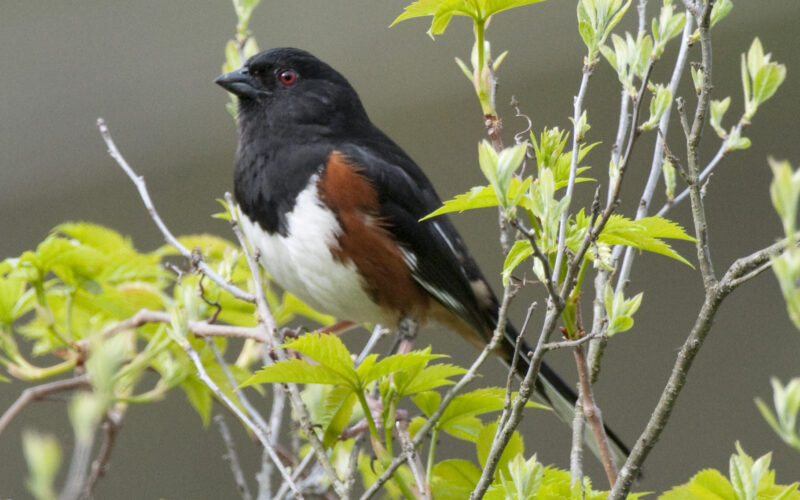



Have a few birds in backyard. In trying to name them. I could get the ones we might see always. So now names for beautiful birds I see.thank you
You are welcome!
And I just updated this page to include more birds.